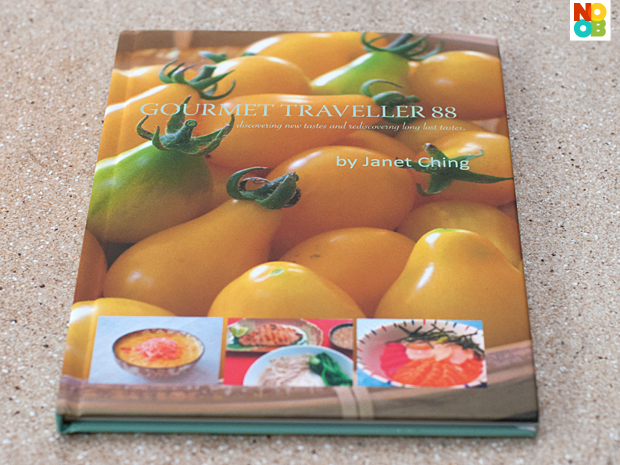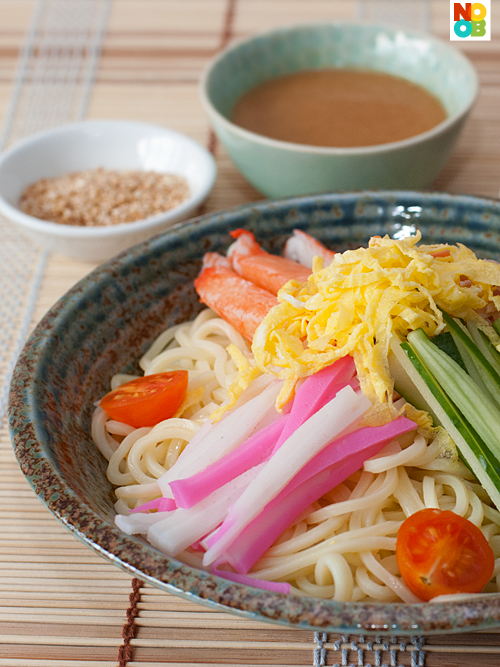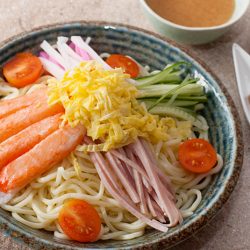Hiyashi Chuka (Japanese Chilled Ramen Noodles)
Hiyashi chuka (冷やし中華) is a Japanese chilled ramen dish with vibrantly colourful toppings and served with a cold sesame-vinegar-soy dressing. For me, this dish was not only love at first sight, it was also love at first bite – I love the chewiness (QQ texture) of the ramen noodles served with a tangy sesame dressing. This noodles dish is served in Japanese eateries in summer, but in tropical Singapore, you can enjoy it from Japanese restaurants all year round. It is really easy to put together, healthy, light and refreshing. You can experiment with all sorts of toppings, such as a meat-free version.
See Also:

This recipe was adapted from my friend’s Janet Ching’s cookbook, Gourmet Traveller 88, named after her website. Janet generously mailed me an autographed copy of her cookbook, and her cookbook is now sitting proudly on my bookshelf of treasured cookbooks. The cookbook was a gift of love from her husband, whom on her birthday, surprised her with published copies of her very own cookbook. The book is compact (therefore easy to refer to in the kitchen) and contains 32 international recipes. The diversity of the food and delicious food photos clearly highlighted Janet’s culinary talent. If you wish to order or enquire about the cookbook, you can email Janet for details.

You can purchase most of the ingredients in Singapore at the Japanese section of major supermarkets. For the ramen noodles, I found them at Isetan Scotts supermarket, and you will also be able to get them at most Japanese-niche supermarkets such as Meidi-ya, Sakuraya, NTUC Finest and Cold Storage Takashimaya.
Hiyashi Chuka Recipe
You can tweak the dressing to your liking – personally, I prefer more rice vinegar for the extra tangy taste.
Ingredients:
- 3 ham slices sliced to long thin strips
- half Japanese cucumber sliced to long thin strips
- 80g kamaboko (Japanese fish cake) sliced to long thin strips
- 8 kanimi (Japanese imitation crab sticks)
- 6 cherry tomatoes halved
- toasted sesame seeds
- karashi (Japanese mustard)
(A) Egg Mixture (Beat evenly)
- 1 egg
- 1 tbsp water
- a small pinch of salt
- 2 dashes of white pepper powder
(B) Sesame Dressing
- 6 tbsp water
- 3 tbsp kinnogomadar (roasted sesame sauce)
- 1/2 tbsp sesame oil
- 3 tbsp Japanese rice vinegar
- 1/2 tsp brown sugar
- 1 1/2 tbsp shoyu (or light soy sauce)
- 1 tsp grated ginger
Directions:
- Heat and grease a pan, then pour half of the egg mixture (A) onto the pan, swirling the pan to spread the egg in a thin layer. When one side is cooked, carefully flip the omelette to the other side. Repeat one more time with the remaining egg mixture. Slice the cooked egg to long thin strips.
- Cook the ramen in boiling water according to the timing indicated in the packaging. Run the cooked noodles in tap water, then dip them in an ice water bath to chill the noodles. Drain and chill the noodles in the fridge until ready to eat.
- Whisk to combine the ingredients for the sesame dressing (B) in a small bowl. Divide to two servings.
- Divide the noodles into 2 serving flat bowls. Drizzle some sesame oil over the noodles.
- Arrange the toppings (egg, ham, cucumber, kamaboko and kanikama) on top of the noodles. Sprinkle toasted sesame seeds and serve on the side, a dollop of karashi and sesame dressing.
Noob Cook Tips
- Ingredients substitution.You may substitute kinnogomadar with tahini, karashi with dijon mustard, and instead of cooking your own egg at step 1, you can purchase ready-cooked tamagoyaki (Japanese rolled egg) from the supermarket.
- Topping suggestions. Other popular toppings include blanched beansprouts, thinly sliced carrot strips, avocado, shredded chicken and boiled prawns.
